Debra H. Goldstein's Blog, page 5
November 4, 2024
TRAVEL INSPIRATION by Anne Louise Bannon
 The classic answer to the perennial “Where do you get your ideas?” question is that ideas are everywhere. They truly are. The fun part is when the idea pops up when you least expect it and you know it’s good, and because of some very special event, the result of that idea is going to be inextricably linked to that special event.
The classic answer to the perennial “Where do you get your ideas?” question is that ideas are everywhere. They truly are. The fun part is when the idea pops up when you least expect it and you know it’s good, and because of some very special event, the result of that idea is going to be inextricably linked to that special event.
To wit – I have just returned from fifteen days in Italy, a trip my husband and I have been actively planning for over two years, and have been longing to take for much, much longer. My husband and I love to travel, but for a lot of years, we just didn’t have the money for more than a quick trip here and there. When our fortunes changed for the better, work concerns and other priorities left little time for extended time away. In other words, this trip really meant a lot to us.
One of several things on my must-do list was to spend some time in a trattoria typing away on my current work in progress. So what if said book takes place in Boston in 1873? Hanging out at an outside table on the Piazza San Marco in Venice was sure to fill me with enough joy that the words would flow. Okay. It just sounded like a really cool thing to do.
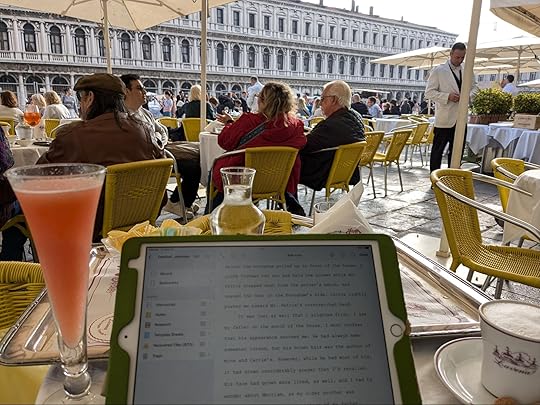
That the rainy weather made the experience literally cool, and that the waiter was a bit of a jerk. That’s part of life. The bigger obstacle? I’d scored a truly awesome idea the day before and it was hard thinking about anything else.
I’m not going to go into the details, but, yeah, it involves the history of Venice and the Doges that ruled it for centuries, and gondolas, and maybe one or two other medieval cities that we visited later in the trip. It might involve a dual time-line that might set up a whole similar series, thanks to another idea I had years ago based on some finds under the Louvre Museum in Paris. (Note to Self – need to find out more about that dig and was it a bashed-in helmet that triggered me?)
There are those who would suggest, justifiably, that I am already swimming in ideas and that the last thing I need is another one to develop. Then again, I am swimming in fabric and patterns. That didn’t stop me from picking up two gorgeous pieces of fabric – a lovely lightweight wool and a gorgeous paisley viscose knit, not to mention a Burda magazine (which contains patterns) in Italian.
Ideas really are everywhere. Some will blossom. Some won’t. The one from the Louvre went nowhere, but I still remember that part of the trip with joy. If this new one goes someplace, great. I’m looking forward to another deep dive into the research deep end. It’s the joy of it that counts right now, like the joy of a long-awaited trip to Italy. It’s even better that the idea and the trip are two parts of a perfectly lovely whole experience.
Speaking of ideas, one of my earlier ones was Paths Not Taken, the thirteenth Operation Quickline story which just had its debut on my blog at annelouisebannon.com/blogs. Or you can sign up for my Substack newsletter and get a new chapter in your email inbox each week, annelouisebannon.substack.com/subscribe. And be sure to check out all my books on my Fiction page, annelouisebannon.com.
Author Anne Louise Bannon’s husband says that his wife kills people for a living. Bannon does mostly write mysteries, including the Old Los Angeles Series, the Freddie and Kathy series, and the Operation Quickline series. She has worked as a freelance journalist for magazines and newspapers, including the Los Angeles Times. She and her husband, Michael Holland, created the OddBallGrape.com wine education blog, and she co-wrote a book on poisons. She and her husband live in Southern California with an assortment of critters. Visit her website at AnneLouiseBannon.com.
The post TRAVEL INSPIRATION by Anne Louise Bannon first appeared on Debra H. Goldstein.
The post TRAVEL INSPIRATION by Anne Louise Bannon appeared first on Debra H. Goldstein.
October 21, 2024
WRITING SATISFYING ANTAGONISTS IN COZY MYSTERIES by Korina Moss
 My number one reminder when writing a cozy? Keep it cozy. It must have a comforting feeling, much like a cup of tea, a warm blanket, a good book, or a relaxing dinner with friends. In fact, one of the main reasons readers say they return to a series is because the characters feel like old friends. The town should be almost idyllic… except for those pesky murders, and there should be just enough tension to keep the pages turning, without overly dark themes. In other words, keep it cozy.
My number one reminder when writing a cozy? Keep it cozy. It must have a comforting feeling, much like a cup of tea, a warm blanket, a good book, or a relaxing dinner with friends. In fact, one of the main reasons readers say they return to a series is because the characters feel like old friends. The town should be almost idyllic… except for those pesky murders, and there should be just enough tension to keep the pages turning, without overly dark themes. In other words, keep it cozy.
But it wouldn’t be a mystery without a murder, and there isn’t a murder without an antagonist. A cozy should have at least five suspects, one of them being the culprit. So how do I write realistic suspects and antagonists without straying too far from my number one reminder? I dismiss the idea of a villain.
Every suspect does not have to be mean, unlikable, or argumentative. In fact, it’s better (read: cozier) if they’re not. Who wants to read a cozy mystery with a bunch of characters they don’t like? Besides, in a cozy, you don’t know a bad guy is the bad guy until the final reveal. Which means you’re forced to make your bad guy three-dimensional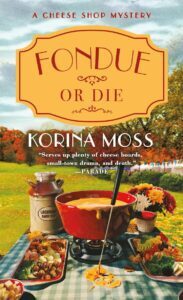 , just like your likable main characters. The best way to do this is to do an exercise I call, Let Me Tell You My Story.
, just like your likable main characters. The best way to do this is to do an exercise I call, Let Me Tell You My Story.
To do this, you free write as your antagonist (from his point of view) for five to ten minutes. This is after you’ve done his backstory and know something about him. In this exercise, put him in a situation where he must react to something, and dig into how he feels. Remember, this is only for you, not intended to be polished or witty or grammatically correct. This is not just an exercise in writing first person. You must get out of your narrator’s head and into your antagonist’s heart.
Because the thing is, nobody sees themselves as the bad guy (except for maybe a Marvel villain). Even negative emotions—anger, jealousy, greed—come from a vulnerable place—hurt, fear, or scarcity. Conversely, your antagonist can also have a positive trait, that when magnified, becomes negative.
Once you dig deeper to find the emotion that’s the driving force of your antagonist, you reveal it in subtle ways throughout the book. For example, you can show your culprit as a loyal friend, and then incorporate subtle signs throughout the book that speak to their loyalty, which cause no red flags for the reader. However, that loyalty, magnified, is the driving force that leads them to protect or avenge through murder the person they were loyal to. Therefore, when your loyal antagonist is revealed as the murderer, it's a believable surprise, because their personality tracked with their motivation as the killer. Thus, writing a three-dimensional antagonist can make for an equally satisfying conclusion for the reader.
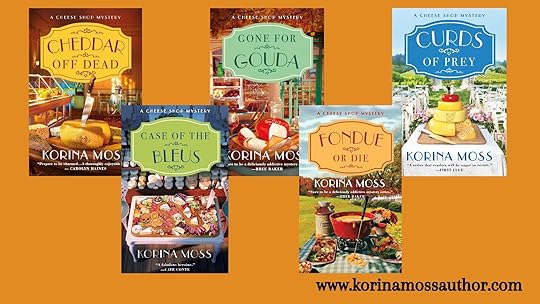 KORINA MOSS is the author of the Cheese Shop Mystery series set in the Sonoma Valley, including the Agatha Award winner for Best First Novel, Cheddar Off Dead and the Agatha Award finalist for Best Contemporary Novel, Case of the Bleus. Her books have been featured in USA Today, PARADE Magazine, Woman’s World, AARP, and Fresh Fiction. To learn more or subscribe to her free monthly #teamcheese newsletter, visit her website, and follow her on Facebook and Instagram.
KORINA MOSS is the author of the Cheese Shop Mystery series set in the Sonoma Valley, including the Agatha Award winner for Best First Novel, Cheddar Off Dead and the Agatha Award finalist for Best Contemporary Novel, Case of the Bleus. Her books have been featured in USA Today, PARADE Magazine, Woman’s World, AARP, and Fresh Fiction. To learn more or subscribe to her free monthly #teamcheese newsletter, visit her website, and follow her on Facebook and Instagram.
Website: korinamossauthor.com
Facebook: facebook.com/korinamossauthor/
Instagram: instagram.com/korinamossauthor/
The post WRITING SATISFYING ANTAGONISTS IN COZY MYSTERIES by Korina Moss first appeared on Debra H. Goldstein.
The post WRITING SATISFYING ANTAGONISTS IN COZY MYSTERIES by Korina Moss appeared first on Debra H. Goldstein.
October 10, 2024
Falling into…Everything! by Maggie Toussaint/Valona Jones

Autumn leaves show us their fall colors first and then they flutter to the ground. Oh, how I enjoyed jumping into leaves as an adult. That’s right. Down where I grew up, our trees are mostly deciduous. Fall was something I read about and saw pictures of but never experienced until I was grown up.
Something about fall that keeps coming to mind today. Perhaps it’s the bright pop of red, orange, and yellow leaves in trees that have been green since spring. Or it might be the whimsical way leaves fall, twirling in the air or wafting along on a stiff breeze.
With fall on my mind, I decided to share the ways my sleuth, Tabby Winslow, falls in my latest release, TALLOWED GROUND. I wasn’t conscious of this thematic element in her characterization until I sat down to write this post.
First, Tabby is falling into trouble. A seemingly routine fishing expedition by Detectives Nowry and Belfor of the Savannah Police Department (SPD) turns into pointed questions. Instead of being a subject matter expert on tallow, she’s a person of interest in a recent homicide. The victim is a man she barely knew but he had been drunk and disorderly in her shop. He’d threatened her. She’d filed a restraining order against him. Now she’s in a deep hole of suspicion.
Second, Tabby believes her boyfriend will propose during their Valentine’s Day romantic dinner. Then just about everyone in the restaurant is saying yes to marriage. It’s annoying and nerve-wracking. Is Quig falling out of love with her? Since she’s totally fallen for him, tiny waves of dissonance occur, keeping her on pins and needles.
And thirdly, once the killer realizes Tabby is after him, he comes for her. Tabby falls into the worst sort of trouble. Worse, she doesn’t know who kidnapped her or where she is. It’s all she can do to be positive in that darkness. She vows to save herself. But she can’t prepare because she doesn’t know who, what, where, or when.
In summary, these layers of “falling” quicken TALLOWED GROUND’s pacing, ratchet up the tension, and according to one reviewer, “High stakes and a creepy setting fuel the tension in this compelling story. A page-turner that will keep you reading into the night!”—Nancy J Cohen, award winning author of The Bad Hair Day Mysteries.
If you’d like to fall into a good book or a good series, check out TALLOWED GROUND, book three of A Magic Candle Shop Mysteries, which came out on September 10, 2024. It is available in digital and trade paperback from most online vendors.
A Bit About TALLOWED GROUND:
When a killer props his third and latest victim against the double tombstone of Tabby and Sage Winslow’s grandparents’ grave in Savannah, Georgia, the psychic twins are stunned. Even worse, the victim is the very man they filed a restraining order against a few months ago for trashing their book and candle shop. Coincidence...or a connection? Then a clue about the murders points to Tabby’s career as a candlemaker. Now, she is a person of interest in the killing spree.
The twins investigate all three victims, finding little that might tie the cases together besides where the bodies were found—in or near Bonaventure Cemetery, a beautiful 100-acre historic graveyard with a storied past. Then Tabby’s Medical Examiner boyfriend is mysteriously pulled from the case, with his dream job in jeopardy. The situation reaches a flashpoint when new evidence points to Tabby. With her freedom and the family business in peril, Tabby matches her wits and psychic abilities against the wily killer.
That is, until Tabby’s spirited inquiry as an amateur sleuth lands her in the worst kind of trouble. Can Tabby clear her name before the fiend snuffs her flame…for good?
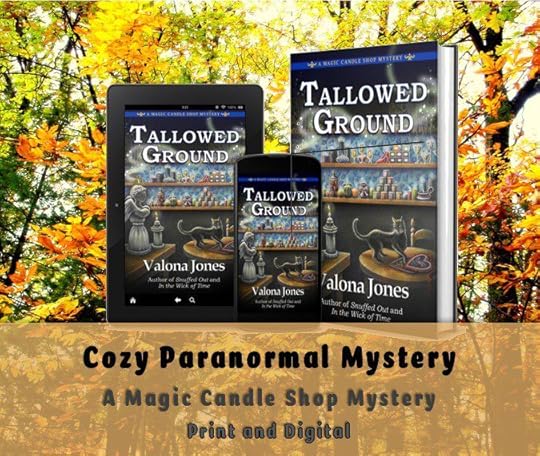
Southern author Maggie Toussaint writes cozy and paranormal mysteries under her name and a pen name of Valona Jones, romantic suspense, and dystopian fiction under the pen name of Rigel Carson, with more than twenty-seven novels of fiction published. Her upcoming release, TALLOWED GROUND, book three in A Magic Candle Shop Mysteries, is a cozy paranormal mystery series written under the pen name of Valona Jones. A multi-year finalist for Georgia Author of the Year, she’s won Silver Falchions, two Readers’ Choice awards, and the EPIC Award. She’s a member of Mystery Writers of America-Southeast chapter and Sisters In Crime-Guppy chapter. She lives in coastal Georgia, where secrets, heritage, and ancient oaks cast long shadows. Visit her at https://maggietoussaint.com/
CREDIT HEADSHOT TO CSAW PRODUCTIONS - (MAGGIE TOUSSAINT HEADSHOT)
The post Falling into…Everything! by Maggie Toussaint/Valona Jones first appeared on Debra H. Goldstein.
The post Falling into…Everything! by Maggie Toussaint/Valona Jones appeared first on Debra H. Goldstein.
September 30, 2024
Shazam! When the Secret Magic Happens by Martha Reed
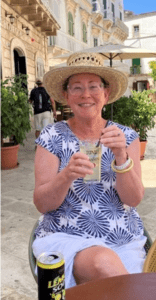
I’m often asked what compels me to write mysteries. I know I’ve always been interested in crime fiction because that’s the genre I’ve read from a very young age. Devouring the Nancy Drew mysteries quickly evolved into reading Sir Arthur Conan Doyle’s Sherlock Holmes, Agatha Christie’s Miss Marple and Hercule Poirot, and Dorothy L. Sayer’s aristocratic sleuth Lord Peter Wimsey and his mystery novelist companion and wife, Harriet Vane.
Why did I cross the threshold from mystery reading enthusiast to mystery author? I hold my beloved grandfather responsible for planting that pernicious seed. He knew I wanted to be a writer. When I was a teenager, we visited a local Barnes & Noble bookstore. He picked up Sue Grafton’s latest alphabet mystery, flipped it open to the author photo on the sleeve, and said: “If she can do it, so can you.”
So here I sit at my laptop, fifty years later with five and half mysteries in two different series under my belt. What a long, strange trip its been.
Looking back with perspective, why do I write? I’ll be brutally honest. It’s not for the money. According to recent Author’s Guild statistics, mystery, thriller, and suspense authors had a median book income of $10,000. When I poll that number to my author friends, most think that’s on the high side, that it’s closer to $5,000 or less. With two mystery series in production, I know I earn enough royalty to pay for my annual mystery convention trips. Generally, I tend to register and attend two or three of those around the country each year. I’m not getting rich, but writing mysteries keeps me busy and gives me a sense of accomplishment. It also gives me a great excuse to travel and catch up with my like-minded friends. That seems like a pretty fair swap to me.
I don’t write for fame although it thrills me when a reader gives my books a starred review or asks for my autograph at a convention. I feel like a rock star for one brief moment before the imposter syndrome comes crashing in and firmly puts me back in my place. If we’re playing true confession, I’ll also admit to the thrill I get when a family member finishes one of my books, looks up in surprise and says: “Seriously. You wrote this?”
The secret reason I love writing mysteries is because ever so rarely creative magic spontaneously happens. I make no claim to knowing how to do it, but it happens often enough to motivate me to keep adding to my current work in progress in case it happens again. Spontaneous creativity is simply the best feeling in the world. What is it? Suddenly, without premeditation or a warning, my storytelling imagination self-connects to a nugget of real time research and BAM. The plotline snaps into place the way a missing jigsaw puzzle piece suddenly pops into sharp focus. Events and characters take on a substance and life of their own. They get real. The story takes off with its own energy and its own tangent and gallops along its own flow like a racehorse returning to the stable. At this point as the author, I’m only along for the ride.
I don’t want to get all woo-woo about this. When I drafted my first novel, this creative spontaneity happened so rarely I chalked it up to pure chance. Now, almost six novels in, I don’t credit coincidence because these magical connections are happening more often. They’ve reached a point where I feel like something omniscient is guiding them to me like a silent partner. As if the story I’m working on is actively working to meet me halfway because the story itself wants to be told.
I’m not the first author to suggest this possibility. At conferences and online podcast interviews, I’ve heard authors say they feel like the story they wrote was channeled through them like water sucked through a straw. In his book On Writing, Stephen King suggested that all stories pre-exist in a common universal consciousness. That authors act more like stenographers than original content creators.
I’m taking the stand that we authors are a bit more proactive on story ownership than that. We put in the time and the effort to hone our craft and explore our creative spaces. We pursue our stories like prey and hunt them down. And if we stay honest and true to our writing talent, we are rewarded. As Sherlock Holmes famously said: “Come, Watson, come! The game is afoot.”
And while we put our heads down and dedicatedly keep typing, we hope: “All will be revealed.”
Martha Reed is a multi-award-winning crime fiction author. Her story, “The Honor Thief”, was included in This Time For Sure, the Anthony Award-winning Bouchercon 2021 anthology. Her initial Crescent City NOLA Mystery, Love Power, won a 2021 Killer Nashville Silver Falchion Award and features Gigi Pascoe, a transgender sleuth. Up Jumped the Devil, the second NOLA Mystery was released in December 2023. Martha is also the author of the Independent Publisher IPPY Book Award-winning John and Sarah Jarad Nantucket Mystery series. Her short stories and articles have appeared in Pearl, Suspense Magazine, Spinetingler, Mystery Readers Journal, Kings River Life Magazine, Mysterical-e, and in two Sisters in Crime anthologies. Lucky Charms - 12 Crime Tales and Paradise is Deadly - Gripping Tales from the Florida Gulf Coast.
LINKS:Website: https://www.reedmenow.com/
Amazon links:
Nantucket Mysteries: https://www.amazon.com/dp/B08X3DYLBD
NOLA Mysteries: https://www.amazon.com/dp/B08KY4FW6P?binding=kindle_edition&ref_=ast_author_bsi
The post Shazam! When the Secret Magic Happens by Martha Reed first appeared on Debra H. Goldstein.
The post Shazam! When the Secret Magic Happens by Martha Reed appeared first on Debra H. Goldstein.
September 16, 2024
It’s Not Always a Mystery…Even When It Is by Judy Penz Sheluk
 You’d think a multi-author anthology titled Larceny & Last Chances: 22 Stories of Mystery & Suspense would only include stories of mystery and suspense. And it does. Kind of. By that I mean, just like Debra’s “It’s Not Always a Mystery” tagline for her website (where it kind of is, but isn’t), several of the stories in the collection are what I’d consider to be non-traditional mysteries.
You’d think a multi-author anthology titled Larceny & Last Chances: 22 Stories of Mystery & Suspense would only include stories of mystery and suspense. And it does. Kind of. By that I mean, just like Debra’s “It’s Not Always a Mystery” tagline for her website (where it kind of is, but isn’t), several of the stories in the collection are what I’d consider to be non-traditional mysteries.
As the publisher and editor, culling 80 submissions down to 21 (plus 1 by yours truly) was up to me. Of course, I’ve included a locked room mystery—because who doesn’t like to try and solve a clever locked room mystery? There’s even a Sherlockian-type entry, a couple of ex-cons—one at a casino, one in the hospital—and a tattoo artist drowning in ‘Red Ink.’ An old family Bible and a priceless viola. A scheming boyfriend and a cheating ex-spouse. A robbery gone wrong, and a robbery gone right.
But there are 22 stories, folks. That leaves 11 that I’d consider, if not non-traditional, bordering on it. A kid with a bag he wants to toss into the water on the Staten Island Ferry. A kleptomaniac who can’t control her urge to steal. A teenager who’ll risk everything to retrieve a thrift shop donation, and another who’d like to stop shoplifting, but desperately wants to keep a promise made to her sister. A messy child custody battle. A jilted lover in the Florida Keys. A hit-and-run accident. A python. A parrot. A charismatic uncle.
Revenge.
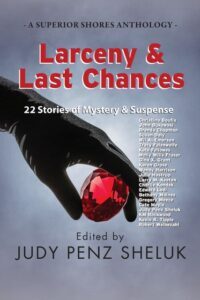
Larceny and last chances. Every author in the collection interpreted the theme in their own unique way. Which begs the question: Just how far would you go if you were faced with your last chance?
About the book: Sometimes it’s about doing the right thing. Sometimes it’s about getting even. Sometimes it’s about taking what you think you deserve. And sometimes, it’s your last, best, chance. Edited by Judy Penz Sheluk and featuring stories by Christina Boufis, John Bukowski, Brenda Chapman, Susan Daly, Wil A. Emerson, Tracy Falenwolfe, Kate Fellowes, Molly Wills Fraser, Gina X. Grant, Karen Grose, Wendy Harrison, Julie Hastrup, Larry M. Keeton, Charlie Kondek, Edward Lodi, Bethany Maines, Gregory Meece, Cate Moyle, Judy Penz Sheluk, KM Rockwood, Kevin R. Tipple, and Robert Weibezahl.
Buy Link: www.books2read.com/larceny
About the editor: Judy Penz Sheluk is a former journalist and magazine editor and the bestselling author of two mystery series, several short stories, and two books on publishing. She is also the publisher and editor of four Superior Shores Anthologies. Find out more at www.judypenzsheluk.com.
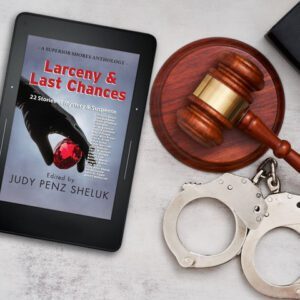
The post It’s Not Always a Mystery…Even When It Is by Judy Penz Sheluk first appeared on Debra H. Goldstein.
The post It’s Not Always a Mystery…Even When It Is by Judy Penz Sheluk appeared first on Debra H. Goldstein.
September 2, 2024
The Big, White Hotel Calling My Name by Kathleen Kaska
 The Luther Hotel is located on the Texas Gulf Coast in the small town of Palacios. You can walk out the front door across a lush, green lagoon and, a few seconds later, have your feet in the water.
The Luther Hotel is located on the Texas Gulf Coast in the small town of Palacios. You can walk out the front door across a lush, green lagoon and, a few seconds later, have your feet in the water.
In 1999, my husband and I hugged the coastline from Rockport to Galveston. When we drove through Palacios, the glittered water of the Gulf of Mexico and the shorebirds and wading birds held our attention. Not once did we turn our heads to the left to check out what was on the other side of the road. We repeated the trip a few months later, and that’s when we noticed the white wooden three-story hotel. How could we have missed it the first time? At the time, I was piecing together Murder at the Arlington and had the Galvez Hotel on my list as a future setting for the series. But this big, white hotel wouldn’t leave me alone. On that second trip, we met innkeepers Billy and Dolly Hamlin, who were living at the hotel and running it for Dolly’s cousin, Clare Joy.
Billy showed us every nook and cranny, boasting of the hotel’s intriguing history. Before we left, we had reservations for the next month. This time, Billy put us in the La Salle suite on the third floor because even after two trips, Billy told us we were family. Once, I attempted to calculate the total number of nights we stayed at the Luther, and I came up with close to fifty. The Luther Hotel was our home on the coast. The La Salle suite was our room.
Since my husband is an early riser, Billy taught him how to set up the breakfast room and make coffee in the huge urn. On a few occasions, Lloyd went to the local supermarket to pick up the hotel’s standing order of donuts and sweet rolls, which were part of the breakfast included in a night’s stay.
A year later, I told the Hamlins I was working on Murder at the Luther. They were ecstatic. A lot has occurred between that announcement and the book’s release. Billy and Dolly retired, and Clare Joy passed away, leaving the hotel to Jack, who was living near Houston. Another family cousin ran the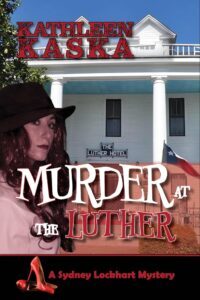 hotel. When the book was released, I contacted the local bookstore, Main Street Books, scheduled a book signing, and I made reservations for several nights at the Luther. To my surprise, Jack came for the weekend to meet me and attend the event. I arrived the day before and went into the bookstore to meet the owner, Jan Pierce. She asked if I had any copies of the book with me. Panic set in. I thought it was understood that she would order books from my publisher to have on hand. She assured me that she had ordered several boxes, but she’d already sold out. I brought her the few copies I had, and we took orders for several more. It was one of the most successful book signing I’d ever had. Jan told me my signing was more successful than Liz Carpenter’s when she was there promoting her book. Carpenter was the executive assistant for LBJ and later Lady Bird’s press secretary.
hotel. When the book was released, I contacted the local bookstore, Main Street Books, scheduled a book signing, and I made reservations for several nights at the Luther. To my surprise, Jack came for the weekend to meet me and attend the event. I arrived the day before and went into the bookstore to meet the owner, Jan Pierce. She asked if I had any copies of the book with me. Panic set in. I thought it was understood that she would order books from my publisher to have on hand. She assured me that she had ordered several boxes, but she’d already sold out. I brought her the few copies I had, and we took orders for several more. It was one of the most successful book signing I’d ever had. Jan told me my signing was more successful than Liz Carpenter’s when she was there promoting her book. Carpenter was the executive assistant for LBJ and later Lady Bird’s press secretary.
After the event, Jack hosted a wine and cheese reception for me at the hotel and presented me with flowers. Jack and I became good friends, and he soon moved to Palacios to take over running the hotel himself. Sadly, Jack passed away in 2020, and the future of the Luther Hotel was destined for the wrecking ball. As of this writing, the Luther is closed but still standing. The story of the hotel’s possible demise and its stay of execution is one that could easily find its way to the big screen. The save-the-farm movies of the 1990s pale in comparison to the true-life story of the locals who rallied to save the Luther Hotel. The Luther is in the early stages of remodeling. As soon as the vacancy sign is up, I’m booking a long stay in the La Salle suite, a room Jack often referred to as the room where Sydney Lockhart stayed when she solved the murder in the mystery Murder at the Luther.
Released day: September 29, 2024.
Now available for pre-order
The post first appeared on Debra H. Goldstein.
The post appeared first on Debra H. Goldstein.
August 19, 2024
All I Know is What I Read in the Papers by Mary Dutta
 Audiences have a seemingly endless appetite for ripped-from-the-headlines plots, as thirty years and multiple iterations of the Law & Order franchise will attest. A faux newspaper headline even features in the opening credits of Law & Order: SVU, in case viewers missed the point.
Audiences have a seemingly endless appetite for ripped-from-the-headlines plots, as thirty years and multiple iterations of the Law & Order franchise will attest. A faux newspaper headline even features in the opening credits of Law & Order: SVU, in case viewers missed the point.
These shows typically open with an incident reminiscent of a notorious crime, but the writers then tell a story of their own devising, featuring the series’ established characters, and delivering a neat ending that might ultimately bear little resemblance to the way events actually played out.
Headlines have inspired many of my own mystery stories as well, but curiously it’s never the crime stories that catch my interest. For instance, a spate of stories about Harry Styles, the singer/actor who rose to fame in the boy band One Direction, made me wonder about his old bandmates. How do they feel about the meteoric rise that left them all behind? For that matter, how do the aging members of NSYNC feel about the fabulous solo success of Justin Timberlake?
My story “The Boyz in the Band,” in the forthcoming Bouchercon conference anthology Tales of Music Murder and Mayhem, explores how those left-behind band members might view the one among them who made it big. How far will they go in trying to capitalize on that former bandmate’s success?
“The Grift of the Magi,” which appeared in the anthology Hook, Line and Sinker, tells the story of the escalating squabbles over a valuable painting owned by a divorcing couple. It has its origins in a news story about the spectacular art collection a billionaire and his wife were compelled to sell off to settle their acrimonious divorce.
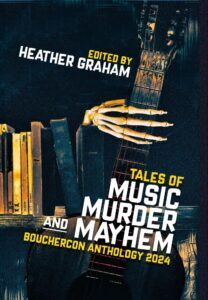
And my story “The Wonderworker,” which won the New England Crime Bake Al Blanchard award for best short crime fiction, was inspired by the breathless news coverage of the famous and/or wealthy parents who bought their children’s way into selective universities in the Varsity Blues college admissions scandal. In my telling, a similarly scheming father will do anything to hire the one wonderworking admissions consultant who can guarantee his child a place at Harvard.
Usually, by the time my stories make it into print the news items that inspired them are no longer front-page fodder. But the human experiences and emotions that inform them, making them newsworthy in the first place, remain. We may never have been famous, but we understand envying others’ success. Maybe we’re not billionaires, but breaking up can be very hard to do, especially when money is involved. And presumably we all want what’s best for our kids, even if we don’t choose problematic means to achieve it.
Will Rogers famously said “All I know is what I read in the papers.” I hope he read beyond the headlines, because there are a lot of stories waiting there to be told.
Mary Dutta is the winner of the New England Crime Bake Al Blanchard Award for her short story “The Wonderworker,” which appears in Masthead: Best New England Crime Stories. Her work can also be found in numerous anthologies including the Anthony-nominated Land of 10,000 Thrills: Bouchercon Anthology 2022. She is a member of Sisters in Crime and the Short Mystery Fiction Society. She lives outside of Birmingham, Alabama (the Magic City) and teaches at The University of Alabama at Birmingham. Visit her at marydutta.com and enjoy her blog at Writers Who Kill.
The post All I Know is What I Read in the Papers by Mary Dutta first appeared on Debra H. Goldstein.
The post All I Know is What I Read in the Papers by Mary Dutta appeared first on Debra H. Goldstein.
August 5, 2024
Disturbing the Universe by Susan Van Kirk
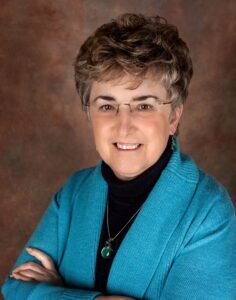 The third and final book of my Art Center Mysteries just came out, and it is designed to end a three-book set. I’d never designed a series with a specific length before, and these three books create an entire story that begins with Death in a Pale Hue, continues through Death in a Bygone Hue, and concludes with Death in a Ghostly Hue. All three have a protagonist, Jill Madison, an oil painter who returns home to her small Midwest town of Apple Grove to run an art center named for her famous sculptor mother. Each book follows her family—she has two polar-opposite brothers—and each has a theme. Family, second chances, and forgiveness are the three themes. So far, so good. But despite this attention to organization, I had the age-old problem of where to start each of these books. “The place to start” is a tough decision, and authors get better at answering this as they practice their craft.
The third and final book of my Art Center Mysteries just came out, and it is designed to end a three-book set. I’d never designed a series with a specific length before, and these three books create an entire story that begins with Death in a Pale Hue, continues through Death in a Bygone Hue, and concludes with Death in a Ghostly Hue. All three have a protagonist, Jill Madison, an oil painter who returns home to her small Midwest town of Apple Grove to run an art center named for her famous sculptor mother. Each book follows her family—she has two polar-opposite brothers—and each has a theme. Family, second chances, and forgiveness are the three themes. So far, so good. But despite this attention to organization, I had the age-old problem of where to start each of these books. “The place to start” is a tough decision, and authors get better at answering this as they practice their craft.
A great start needs to keep the reader reading. A “hook” is what does that. A writer must design an early event that will disturb the main character’s universe. In mystery publisher parlance, “have the dead body drop as soon as possible.” So, if not a body, at least disturb the universe. Let’s consider the humble hook for now.
Here are the hooks in my trilogy, without any spoilers, of course.
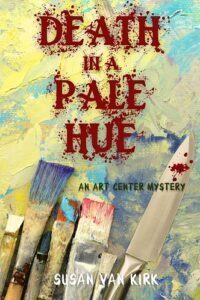 Death in a Pale Hue introduces the Madison family, but when it opens, Jill is rushing across town in the back seat of a police car. She’s just started her job as the executive director of the Adele Marsden Center for the Arts, and someone has stolen a priceless statue created by Jill’s mother. How did they get in? Why didn’t the alarm work? Does the insurance cover the whole cost of such an important piece of artwork? Will Jill be fired from her job? While we are contemplating these questions along with Jill, workers come to do renovation work and find a body buried in the basement. Worse yet, it was someone Jill knew…well.
Death in a Pale Hue introduces the Madison family, but when it opens, Jill is rushing across town in the back seat of a police car. She’s just started her job as the executive director of the Adele Marsden Center for the Arts, and someone has stolen a priceless statue created by Jill’s mother. How did they get in? Why didn’t the alarm work? Does the insurance cover the whole cost of such an important piece of artwork? Will Jill be fired from her job? While we are contemplating these questions along with Jill, workers come to do renovation work and find a body buried in the basement. Worse yet, it was someone Jill knew…well.
Have I hooked you yet?
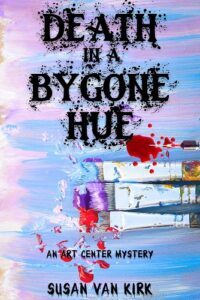 My editor is always saying “don’t wait until chapter four or five to drop the body.” I pleased her enormously when the dead body appeared in chapter one of Death in a Bygone Hue. The reader has met Judge Ron Spivey in Book One, and remembers he is a retired judge who is treasurer of the art center board. More importantly, he is an old family friend and mentor to Jill. When she goes to his house for their scheduled lunch, she finds him dead on his office floor. Talk about a shock! Everyone loved Judge Spivey, well everyone but the last person who saw him alive. And we soon find out he left his children out of the will for his enormous estate and named Jill and the art center instead. This immediately puts a target on Jill’s back, because if she doesn’t survive the probate period, his nasty children will reap the millions.
My editor is always saying “don’t wait until chapter four or five to drop the body.” I pleased her enormously when the dead body appeared in chapter one of Death in a Bygone Hue. The reader has met Judge Ron Spivey in Book One, and remembers he is a retired judge who is treasurer of the art center board. More importantly, he is an old family friend and mentor to Jill. When she goes to his house for their scheduled lunch, she finds him dead on his office floor. Talk about a shock! Everyone loved Judge Spivey, well everyone but the last person who saw him alive. And we soon find out he left his children out of the will for his enormous estate and named Jill and the art center instead. This immediately puts a target on Jill’s back, because if she doesn’t survive the probate period, his nasty children will reap the millions.
Now, are you hooked?
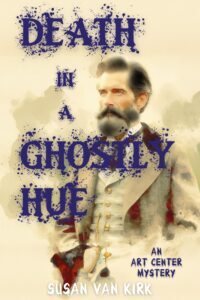 Finally, the newest and last book of the trilogy, Death in a Ghostly Hue. Throughout the series, the Madison parents are a lingering presence. Seven years earlier, they died in a car crash with a man who was driving drunk. The three adult Madison children have struggled to put their lives back together in the wake of that tragedy. In chapter one, who should return home after seven years in prison but the very man who killed them? He shows up at Jill’s art center and informs her he plans to stay in Apple Grove. It’s his home. Quinn Parsons not only killed the Madison parents in this accident, but also one of his friends, and he put another friend in a wheelchair for life.
Finally, the newest and last book of the trilogy, Death in a Ghostly Hue. Throughout the series, the Madison parents are a lingering presence. Seven years earlier, they died in a car crash with a man who was driving drunk. The three adult Madison children have struggled to put their lives back together in the wake of that tragedy. In chapter one, who should return home after seven years in prison but the very man who killed them? He shows up at Jill’s art center and informs her he plans to stay in Apple Grove. It’s his home. Quinn Parsons not only killed the Madison parents in this accident, but also one of his friends, and he put another friend in a wheelchair for life.
Would you like to take any bets on how long he lasts with so many people who aren’t thinking about forgiveness?
One of my earliest lessons as a writer was to learn when and where to start my story. In “The Love Song of J. Alfred Prufrock,” T.S. Eliot asked: “Do I dare disturb the universe?”
Heck yes, if you’re a mystery writer. And do it soon.
Susan is kindly giving away a paperback copy of the newest book to a lucky commenter (US only). She will check names and comments through August 7 for the giveaway. In your comment, please include your email address.
Her books can be purchased at:
Amazon: https://tinyurl.com/3du9vh5c
Bookshop.org https://tinyurl.com/mvvsmdbk
Susan Van Kirk is a Midwest writer, living in downstate Illinois. Her writings include the Endurance Mysteries, a smalltown series republished by Harlequin Worldwide Mystery. A Death at Tippitt Pond is a standalone mystery. Her Art Center series includes Death in a Pale Hue, Death in a Bygone Hue, and Death in a Ghostly Hue. She is a member of Mystery Writers of America, Sisters in Crime, and is Past President of the Guppy Chapter of Sisters in Crime. Her website and blog are at http://www.susanvankirk.com .
The post Disturbing the Universe by Susan Van Kirk first appeared on Debra H. Goldstein.
The post Disturbing the Universe by Susan Van Kirk appeared first on Debra H. Goldstein.
July 22, 2024
Button-Pushing Characters by Lois Winston
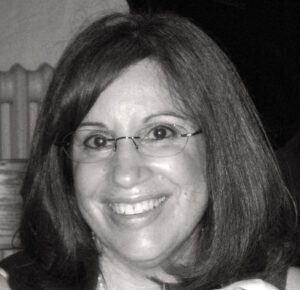 I’m currently reading a book about a less-than-likable protagonist. If I were reading it for pleasure, I would have stopped by now, but I had agreed to review the book. I will plow ahead, hoping the protagonist eventually sees the error of her ways and miraculously develops some much-needed empathy. However, since I’m three-quarters of the way through, it’s not looking good.
I’m currently reading a book about a less-than-likable protagonist. If I were reading it for pleasure, I would have stopped by now, but I had agreed to review the book. I will plow ahead, hoping the protagonist eventually sees the error of her ways and miraculously develops some much-needed empathy. However, since I’m three-quarters of the way through, it’s not looking good.
The last few years have seen a surge in novels featuring unlikable female protagonists, also known as antiheroes. I think it possibly began with Gone Girl. When the publishing industry sees a book take off, they tend to glut the market with similar plots and/or characters.
I’m not saying that every character in a book should be likeable. But for those of us who read to escape, we do tend to want to like the protagonists of the books we read. If the protagonist starts off with irritating flaws, that’s okay, as long as she experiences character growth throughout the book and ends up overcoming at least most of her shortcomings. As a reader, I crave happy endings, especially these days, with what’s going on in the world.
Unlikeable characters often push readers’ buttons. They cause conflict in our protagonists’ lives. However, they’re a necessary part of most stories, especially in mysteries where the antagonists are rarely, if ever, likeable. How often have you read a mystery that ended with a likeable character unmasked as the murderer?
However, books are more than just the conflict between the protagonist and antagonist. They’re populated with many secondary characters, some likeable and some far from likeable. This adds layering to stories. Mystery should be about more than the sleuth discovering whodunit. Otherwise, the story will read like a police report.
A sleuth shouldn’t live in a vacuum. She needs to interact with family and friends. Rarely are all the people in our own lives likeable. So why should that be any different for the protagonist? Characters need goals, motivations, and conflicts. Conflicts between coworkers, neighbors, and relatives not only add dimension to mysteries, but they often provide red herrings.
In my humorous Anastasia Pollack Crafting Mystery series, I have several unlikable characters who push both my protagonist’s and my readers’ buttons. Some readers would like nothing better than to have me kill off these characters, but for the most part, they’re the characters my readers love to hate. This is because along with pushing readers’ buttons, they provide comic relief.
This is especially true of both my sleuth’s mother and mother-in-law. Anastasia’s mother-in-law is a diehard communist and leader of the octogenarian Daughters of the October Revolution. Her mother claims descent from Russian nobility and is social secretary of the Daughters of the American Revolution. Sparks fly in the Pollack household whenever those two are under the same roof—which, unfortunately, is far more often than Anastasia would prefer.
I’ve always been drawn to quirky characters, and I often base my characters on people I’ve known. Usually, I take traits from various people, exaggerating them, and blending them together to create the unique characters that fill the pages of my books. Most people aren’t as quirky in real life as they are on the printed page.
The exception is Anastasia’s mother-in-law. With a few minor differences, Lucille Pollack’s personality (along with her communist leanings) mirror that of my deceased mother-in-law. Love her or hate her, Lucille pushes readers’ buttons, and that’s a good thing. As an author, I always want the characters in my books to stir emotions in my readers.
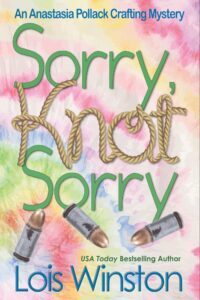
Sorry, Knot Sorry is the thirteenth and latest book in my series, and ofcourse, you’ll find some quirky characters. Will any of them push your buttons? I’d love to hear from you after you’ve read the book.
Meanwhile, post a comment telling me some of the things that push your buttons in either fiction or real life, and you’ll have a chance to win a promo code for a free download of any one of the first ten audiobooks in the Anastasia Pollack Crafting Mysteries.
Sorry, Knot Sorry
An Anastasia Pollack Crafting Mystery, Book 13
Magazine crafts editor Anastasia Pollack may finally be able to pay off the remaining debt she found herself saddled with when her duplicitous first husband dropped dead in a Las Vegas casino. But as Anastasia has discovered, nothing in her life is ever straightforward. Strings are always attached. Thanks to the success of an unauthorized true crime podcast, a television production company wants to option her life—warts and all—as a reluctant amateur sleuth.
Is such exposure worth a clean financial slate? Anastasia isn’t sure, but at the same time, rumors are flying about layoffs at the office. Whether she wants national exposure or not, Anastasia may be forced to sign on the dotted line to keep from standing in the unemployment line. But the dead bodies keep coming, and they’re not in the script.
Craft tips included.
Find Buy Links at https://www.loiswinston.com/sorry-knot-sorry.
USA Today and Amazon bestselling and award-winning author Lois Winston writes mystery, romance, romantic suspense, chick lit, women’s fiction, children’s chapter books, and nonfiction. Kirkus Reviews dubbed her critically acclaimed Anastasia Pollack Crafting Mystery series, “North Jersey’s more mature answer to Stephanie Plum.” In addition, Lois is a former literary agent and an award-winning craft and needlework designer who often draws much of her source material for both her characters and plots from her experiences in the crafts industry. Learn more about Lois and her books at her website www.loiswinston.com where you can also sign up for her newsletter and follow her on various social media sites.
The post Button-Pushing Characters by Lois Winston first appeared on Debra H. Goldstein.
The post Button-Pushing Characters by Lois Winston appeared first on Debra H. Goldstein.
July 8, 2024
Why a Story or Idea is Never a One and Done Deal by Debra H. Goldstein
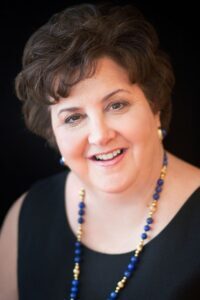 Usually, I introduce you to writers you might not otherwise know through my blog. This time, I’m going to tell you a personal secret that it often takes authors a few years to realize: a story or idea is never a one and done deal. They can often be recycled in numerous ways.
Usually, I introduce you to writers you might not otherwise know through my blog. This time, I’m going to tell you a personal secret that it often takes authors a few years to realize: a story or idea is never a one and done deal. They can often be recycled in numerous ways.
For example, the first story I ever had published, “Malicious Mischief,” featured a young married male lawyer, his mother, the players in his mother’s Mah Jongg game, and a former Nazi. The story won an award. A year later, a different version of the story and characters won another award. Four years later, when I was writing Should Have Played Poker: a Carrie Martin and the Mah Jongg Players Mystery, I realized that the main character, Carrie Martin, was going to have a complex back story. To balance the serious nature of her character for readers, I needed to introduce some form of comic relief. I tried different sidekicks, but nothing felt right. That’s when I remembered my favorite “Malicious Mischief” Mah Jongg players. Their revival became the perfect foil for Carrie.
In 2015, Bethlehem Writers Roundtable published my short story, “This Is Where I Buried My Wives.” The idea for it came from TV commercials for a dating service that had people seeking mates to enjoy a farm related life. The emphasis wasn’t on the meet-up, but what happened after the characters were building a relationship. It was a fun story to write, but nothing I intended to visit again. Then, last year, Tough Magazine announced a call for rural stories, and they were willing to take reprints. “This Is Where I Buried My Wives” seemed perfect – it was in the word count, the theme was what they were looking for, and the story was a bit different than what I thought most of the submissions would be. I sent it in. It was accepted and run. Not only was it nice to have a story find a second home, but getting a check for the tale again was also pleasing.
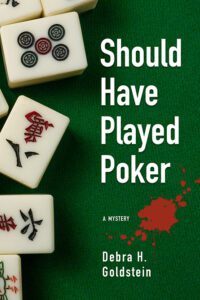
This month, issue 152 of Black Cat Magazine Weekly (which should publish on July 28) should feature a Barb Goffman reprint selection of “Harvey and the Red-Head.” The story was originally published in 2019 in an anthology of Texas related stories, The Eyes of Texas: Private Eyes from the Panhandle. I can’t tell you how excited I was when Barb contacted me that she wanted to republish the story. This means that new eyes will see my work. Once again, the premise of a piece not being a one and done deal will be proven true.
Finally, I recently signed a contract for publication of a collection of many of my early short stories. Watch my website, https://www.DebraHGoldstein.com, for more details. The book, with multiple tales, will underscore that a story or idea doesn’t fade away after being birthed into the world.
The post Why a Story or Idea is Never a One and Done Deal by Debra H. Goldstein first appeared on Debra H. Goldstein.
The post Why a Story or Idea is Never a One and Done Deal by Debra H. Goldstein appeared first on Debra H. Goldstein.



